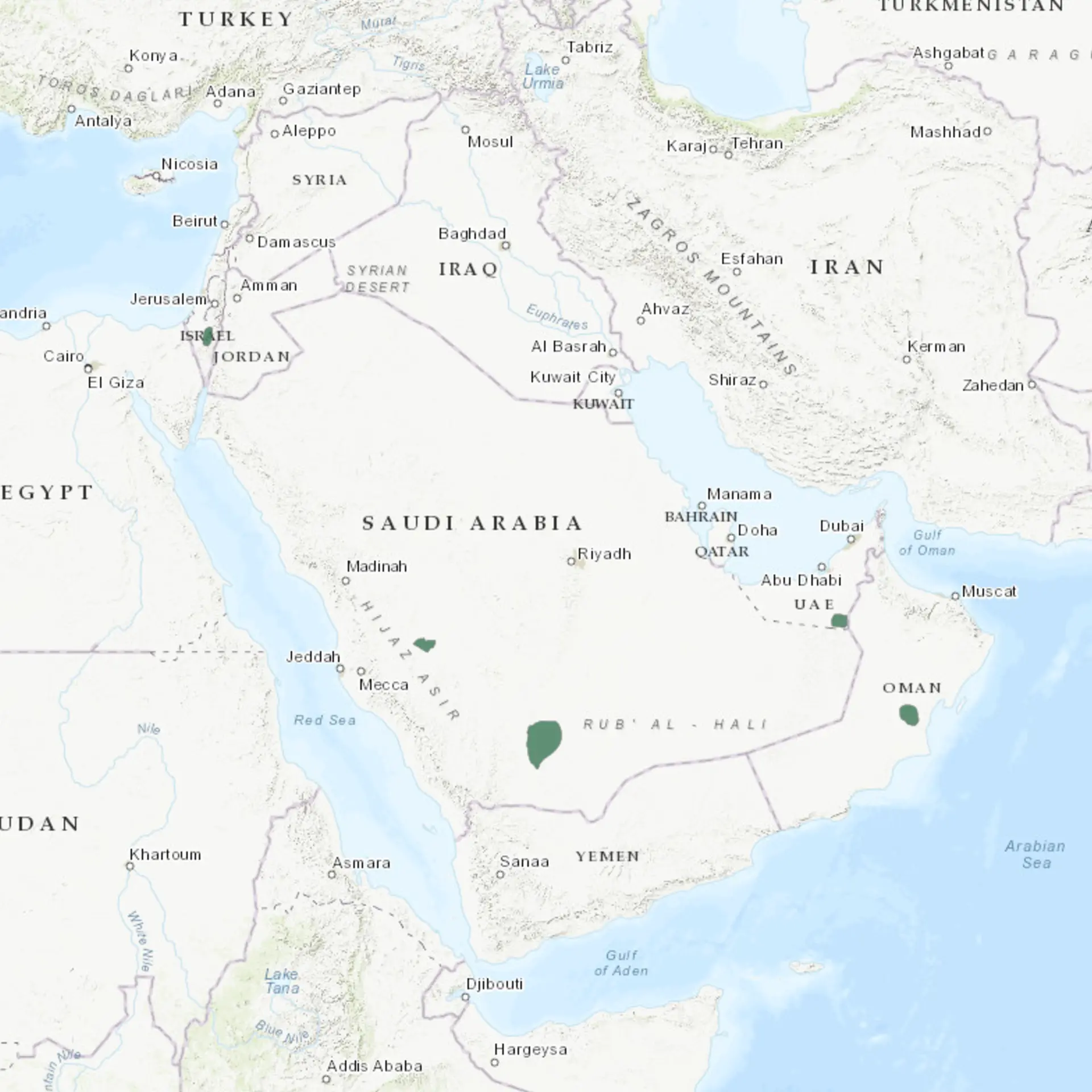Overview
The Arabian Oryx, or white oryx, is a species of antelope that was once on the brink of extinction but has since seen a significant recovery due to conservation efforts. Native to the desert and steppe environments of the Arabian Peninsula, this medium-sized antelope features a striking white coat, a slight hump on the back, and long, straight horns in both males and females. Their white fur reflects the sun’s heat, and their broad hooves are adapted for traversing loose desert sand.
Regarding body shape, the Arabian Oryx has a slightly raised rump, with the hindquarters being higher than the shoulders. Their bodies are muscular and lean, designed to endure the harsh desert conditions. The tail is tufted at the end, while their faces bear a distinctive dark patch around the eyes, providing them with natural “sunglasses” against the desert glare.
Historically, the Arabian Oryx held significant cultural value in the Arab world and was associated with wealth, beauty, and the appreciation of life in a harsh environment. Today, it symbolizes conservation and preservation efforts in the Arabian Peninsula and worldwide.
Taxonomy
Kingdom
Phylum
Class
Order
Family
Genus
Species
Type
Current distribution:
The Arabian oryx is currently found in protected reserves and reintroduction sites across the Arabian Peninsula, with significant populations in Oman, Saudi Arabia, and the UAE. Reintroduction programs have successfully established wild populations in areas such as Oman’s Jiddat al-Harasis, the Mahazat as-Sayd reserve in Saudi Arabia, and the UAE’s Sir Bani Yas Island. These protected areas offer the controlled environments necessary for the oryx to thrive in the wild. However, populations outside protected regions remain highly vulnerable to habitat degradation and illegal hunting.
While the species has been successfully reintroduced, its distribution remains fragmented, with populations existing as isolated groups. These groups are closely monitored and managed to prevent inbreeding and maintain genetic diversity. As part of international conservation efforts, the Arabian oryx has also been introduced to non-native locations, such as Israel’s Negev Desert. Although their numbers are increasing, continued management and habitat protection are crucial for long-term survival.
Physical Description:
The Arabian Oryx is medium-sized, sturdy and well-adapted to life in harsh desert environments. It stands out due to its distinctive, nearly all-white fur, except for dark markings on the forehead and lower parts of the face. The almost luminous white coat reflects sunlight, helping to keep the animal cool in the intense desert heat.
The oryx is also distinguished by its long, straight, ringed horns, which can reach 2 feet or more long and are present in both males and females. In males, the horns are usually thicker with a slight curvature. The animal’s broad, flat hooves are well suited for walking on sand without sinking.

Lifespan: Wild: ~15 Years || Captivity: ~20 Years

Weight: Male: 154-180 lbs (70-82 kg) || Female: 140-160 lbs (64-73 kg)

Length: Male: 5.7-6.1 ft (175-185 cm) || Female: 5.3-5.6 ft (160-170 cm)

Height: Male: 3.3 ft (100 cm) || Female: 3.0 ft (90 cm)

Top Speed: 37 mph (60 km/h)
Characteristic:
Native Habitat:
The Arabian oryx is native to the deserts and arid plains of the Arabian Peninsula, including regions in Saudi Arabia, Oman, the United Arab Emirates, and Jordan. It thrives in open, flat desert plains, gravel deserts, and dunes, where its white coat provides effective camouflage against the light-colored terrain. The species prefers sparse vegetation, such as grasses, shrubs, and thorny bushes, essential for food and cover. These habitats are characterized by extreme heat, low rainfall, and sparse water availability, all of which the oryx is uniquely equipped to endure.
The oryx avoids rugged mountainous areas and dense vegetation, relying on open spaces to detect predators and roam freely. Its natural range once extended across much of the Arabian Peninsula, but habitat destruction and overhunting led to its local extinction in many areas. Thanks to conservation and reintroduction efforts, Arabian oryx populations have been re-established in several parts of their historical range. Their ability to survive in some of the harshest climates on Earth highlights their exceptional desert adaptations.
Climate Zones:
Biomes:
WWF Biomes:
Biogeographical Realms:
Diet:
Diet & Feeding Habits:
The Arabian oryx is an herbivore that feeds primarily on desert grasses, herbs, roots, and the occasional fruits and pods of acacia trees. It is well-adapted to its arid environment and obtains most of its water needs from the moisture in its food. During extreme droughts, the oryx has been observed digging in the sand to uncover roots and bulbs rich in water. This foraging strategy allows it to survive in scarce and unpredictable vegetation.
This species is primarily a grazer but will browse opportunistically when grasses are unavailable. It is crepuscular, feeding during the cooler hours of dawn and dusk to avoid the intense midday heat. Arabian oryx have an acute sense of smell, enabling them to locate distant water sources or areas with recent rainfall. Their diet contributes to the health of desert ecosystems by promoting seed dispersal and preventing vegetation overgrowth in certain areas.
Mating Behavior:
Mating Description:
The Arabian oryx exhibits a polygynous mating system, where dominant males compete to access multiple females within their territory. Breeding can occur year-round, but it is more common after periods of rainfall, which ensures better food availability for lactating females and young. Males establish territories by marking boundaries with dung piles and defending them against rival males through displays and occasional physical confrontations. Courtship involves males following females, displaying horns, and engaging in low-pitched vocalizations.
Gestation lasts about 8–9 months, after which a single calf is born, although twins are rare. Calves are precocial, standing and walking within hours of birth, and they remain hidden in vegetation for the first few weeks to avoid predation. Females provide all parental care, nursing their young for up to 3–4 months, after which calves begin grazing. Arabian oryx reach sexual maturity at around 1.5–2 years of age, and their reproductive success is closely tied to the availability of resources in their harsh environment.
Reproduction Season:
Birth Type:
Pregnancy Duration:
Female Name:
Male Name:
Baby Name:
Social Structure Description:
Arabian oryx are social animals typically live in herds of 5 to 30 individuals. Herds are usually composed of a dominant male, multiple females, and their offspring, although smaller bachelor groups of males are also common. The social hierarchy within herds is established through displays of dominance, with physical confrontations being rare. Herds are highly mobile, traveling long distances for food and water, and their cohesion helps them avoid predators.
During the breeding season, dominant males defend territories, while females and young form looser social groups. Communication within the herd involves a range of visual and vocal signals, including head postures and snorting sounds. Calves stay close to their mothers and gradually integrate into the herd as they grow. This social behavior protects predators and enhances foraging efficiency in their challenging environment.
Groups:
Conservation Status:
Population Trend:
The Arabian Oryx once roamed freely across the deserts of the Arabian Peninsula. Still, by the 1970s, unregulated hunting had brought them to extinction, and the last wild individual was shot in 1972. Since then, thanks to dedicated conservation efforts, Arabian Oryx’s population has steadily increased.
Reintroduction programs in Oman, Saudi Arabia, and Jordan, as well as captive breeding efforts, have increased their population in the wild. Saudi Arabia’s Mahazat as-Sayd Protected Area has the largest wild population. Despite these increases, the Arabian Oryx is still considered Vulnerable due to its small population size and the threats of poaching and habitat loss.
Population Threats:
The primary threats to the Arabian oryx include habitat destruction, illegal hunting, and competition with domestic livestock for limited resources. The expansion of agriculture and urban development has significantly reduced the availability of suitable habitats, leading to population fragmentation. Poaching for its horns and meat was the primary cause of its initial extinction in the wild and remains a concern in some regions. Additionally, climate change poses a long-term threat by altering the availability of food and water in its arid habitat.
Livestock grazing in oryx habitats often leads to resource depletion, reducing food availability for wild populations. Isolated populations are also vulnerable to genetic issues such as inbreeding, which can reduce overall fitness and adaptability. Diseases introduced by domestic animals can further threaten already small populations. While reintroduction programs have mitigated many threats, ongoing efforts are needed to address these challenges and maintain stable populations.
Conservation Efforts:
Conservation efforts for the Arabian oryx began in the 1960s with the establishment of captive breeding programs such as the “World Herd” in Phoenix, Arizona. This initiative and similar programs in the Arabian Peninsula provided the foundation for the species’ reintroduction to the wild. Protected reserves in Oman, Saudi Arabia, and the UAE now serve as strongholds for wild populations, offering a safe environment for the oryx to thrive. These reserves are carefully managed to maintain food, water, and genetic diversity.
International cooperation has been critical, with organizations such as the IUCN, UNESCO, and regional governments working together to protect the species. Ecotourism and public awareness campaigns have helped raise funds and support conservation initiatives. Reforestation and habitat restoration programs aim to expand suitable habitats and create corridors between isolated populations. Captive breeding programs remain vital, ensuring a steady supply of healthy individuals for reintroduction efforts.
Additional Resources:
Fun Facts
- The Arabian Oryx is the national animal of Jordan, Oman, the UAE, Bahrain, and Qatar.
- Their horns are so straight that the ancient Greeks believed the Oryx to be the Unicorn as only one horn can be seen from the side view.
- They can smell rain and are known to travel towards it, which can often be dozens of kilometers away.
- The Arabian Oryx is believed to be able to detect rainfall from a distance of up to 50 km.
- They can survive without water for several weeks, getting the moisture they need from the plants they eat.
- The Arabian Oryx was the first species to be moved from the “Extinct in the Wild” to “Vulnerable” status on the IUCN Red List.
- Their white coat reflects sunlight, reducing heat absorption and helping them survive in the hot desert environment.
- Both males and females have long, sharp horns, which they can use for defense.
- Newborn calves are able to run with the herd just hours after birth.
- They were once a symbol of wealth and prosperity in ancient Arabian culture.













































































